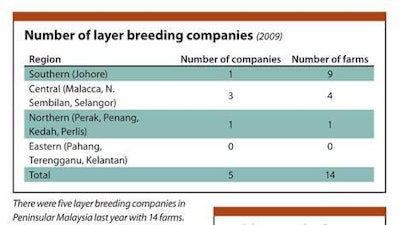
While reports from the Asian poultry industry have all too often been associated with avian influenza and contamination, growth in the region means that the various Asian countries are becoming ever more important players in the global egg market.
Malaysia is self-sufficient in eggs, and exports to a number of neighboring countries.
Number of layer breeding companies
The country’s production of table eggs is expected to reach 8,295 billion eggs this year, up from 7,629 billion in 2009, when a 1.5% increase was recorded, and per capita consumption stands at 265 units, ranking Malaysian’s among the world’s greater consumers of eggs.
The country is both in importer and exporter of eggs and egg products.
Egg imports reached 2,452.45 metric tons last year, with 59,400 classed as specific pathogen free. Of more note, however, is the fact that 2009 saw the country’s egg exports increase by 40% compared to the year before. Most were exported to Singapore, while the rest were destined for Brunei and Indonesia. Exports totaled 1,166.35 billion eggs.
Resources
Malaysia’s Department of Veterinary Services (DVS) reports that there were five layer breeding companies operating in Peninsular Malaysia last year, and that the total female stock stood at 455,877. The breeds used were Hisex, Lohmann, ISA Brown, ISA Warren, H & N Brown Nick and Hyline.
Sources of supply of day-old female parent stocks
From surveys carried out in mid-2009, the DVS notes that the five layer breeding companies operated 14 farms, and that the level of breeding stock ranged from the smallest of some 27,000 birds to the largest of more than 208,000 birds.
Day old pullet production last year stood at 30.98 million birds, with the smallest producer producing 1.87 million chicks and the largest company 11.43 million chicks. This year, total production of day old pullets is expected to decline slightly to 30.82 million. Prices this year are expected to be similar to those recorded for 2009 at RM1.70 to RM2.00.
Last year, the country imported 99,725 day old layer grand parent and 285,404 parent stocks with a cost, insurance and freight value of RM10.09 million. There were no exports of layer birds reported last year.
Breeds of layer parent stocks and percentage of market share
Malaysia did, however, record exports of fertile eggs last year, mainly to Indonesia and Hong Kong, with a total of 3,003,960 being exported.
The DVS further reports that feed prices, despite fluctuations, remained high last year, with an average price of RM1,592 per metric ton of layer feed.
Table egg production
According to the Federation of Livestock Farmers of Malaysia, there are approximately 374 layer farms in the country, producing 7,772 million eggs per annum. Six companies are thought to product in excess of 1 million eggs each day.
All eggs are marketed through wholesalers as fresh in shell eggs, and there are presently two egg processing plants in operation producing various forms of liquid eggs for the bakery and confectionary industries.
The DVM reports slightly different figures, reporting that egg production stood at 7,629 billion last year, an increase of 1.5% compared with the year before. For 2010, this is expected to climb to 8,295. Production on a daily basis ranged from 15.40 million to 25.03 million, and this is expected to stand at between 19.19 million and 26.78 million this year.


















